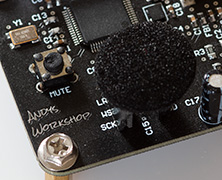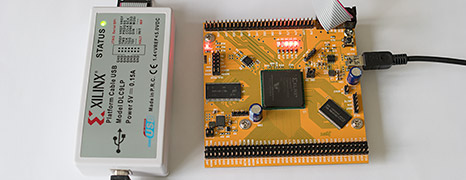I’m a subscriber to ST’s regular email newsletter and though most of it isn’t interesting to me I did notice that in one of the recent editions they were promoting their wireless range of STM32-based MCUs. As a big fan of the STM32 this caught my eye and co-incided with some...
Fixing the USB microphone mute button click
posted by Andy
In my previous article I documented the design and build process of my USB microphone based around an STM32F446 MCU. If you haven’t already read it then it’s probably worth catching up now before reading the rest of this article so that you have the necessary context. The...
A USB microphone for online meetings
posted by Andy
Here in the UK the new reality of working in the IT business over the past year has been that we’re all at home working remotely over virtual desktop connections and for someone engaged in software development this is a setup that works well. Having to commute 90 minutes each way into...
A development board for an STM32G081 MCU
posted by Andy
I’ve been an avid user of ST’s F0 series ever since it was launched. The 48MHz Cortex M0 is almost always the perfect MCU for every project that I tend to build and it’s so easy to program and debug that, for me, it’s the default answer to ‘which MCU should I use...
How to use a 4k TV as a computer monitor
posted by Andy
I like big, high resolution monitors. The bigger the better. I can’t understand how so many young developers and engineers seem to be content to peer into the tiny screens on their Macbooks that offer only a few visible lines of code in perhaps two simultaneous columns, with any...
Directly driving a 7-segment LED display with the STM32
posted by Andy
Seven segment LEDs are an extremely cost effective way to add a large, bright and very readable numeric display to your project. Displays similar to the one pictured above can be had for as little as 50 cents each on ebay in the common heights of 0.56″, 0.36″ and 0.28″. You...
Process automation: another RTD sensor board
posted by Andy
In a previous article I described the design and build of a temperature sensor board based around a high precision LTC2986 part from Linear Technology. The project was successful so you may be wondering why I’m bothering to design another board when the LTC2986 probably cannot be...
Process automation: temperature sensing
posted by Andy
My previous article documented how I designed and built a PCB that hosted three relays and a triac that could be mounted inside a PC case and connected up via the USB bus for host control using simple commands. The relays and triacs board That board is of course the output part of the system,...
Process automation: relays and triacs
posted by Andy
In my previous article I discussed how I intended to convert an old PC into a controller that I could use to automate the temperature control required to ferment and conditional beer. If you haven’t already read that introduction then I’d encourage you to do that so you know what...
Process automation: building a process controller
posted by Andy
Not a lot of people know this, but I brew my own beer as a hobby; and I’m not talking about the murky coloured astringent tasting dodgy brews of yesteryear. The beer I brew is probably best described as craft ale. I do the whole process, much like a brewery would. I design recipes, crush...
A laser-cut acrylic case for my server power supply controller
posted by Andy
In my last article I built a controller board around the Artesyn NXA66 server power supply module that I picked up very cheaply on ebay. This board gave me the ability to control the key functions of the module and formed the basis for a rather nice, high current desktop PSU for voltages of...
A high current power supply built around a server voltage regulator
posted by Andy
Regular readers of this blog will have already seen the article that I published about 4 months ago where I attempted to reverse engineer a voltage regulator module originally designed to fit into a Dell server. The theory was that these would be high quality, stable and robust designs that...
GPS Disciplined Oscillator review and teardown
posted by Andy
You may recall that about a year ago I built a frequency counter based on an FPGA and an Android user interface. I called it Nanocounter and you can read about it here if you haven’t already done so. One of the basic requirements for building a frequency counter is the ability to...
Reverse engineering a server CPU voltage regulator module
posted by Andy
A recent ebay fishing expedition yielded an interesting little part for the very reasonable sum of about five pounds. It’s a voltage regulator module from a Dell PowerEdge 6650 Xeon server. I originally bought this because I had the idea of salvaging parts from it to use in another...
Old, not obsolete. Working with the Xilinx Virtex-E FPGA in a huge BGA package.
posted by Andy
Let me see now, it must have been about two years ago when this story started. I was bored. I can’t remember why but when I’m bored I often surf ebay just to see what interesting bits and pieces are out there. Mostly it’s the same old stuff repeated over and over. Cheap bare PCB modules from the far east at the low end and chancers wanting $1000 for a broken oscilloscope at the other. This time though I found something interesting. Someone in Sweden was selling a job lot of forty factory-sealed Virtex-E FPGAs for what amounted to two quid each. And they were big ones — the XCV600E-6FG676. ‘Virtex’ is...
An acrylic case for Nanocounter
posted by Andy
You may have already read my writeup about my first experience with laser cutting and the case that I produced for my reflow oven controller. If not then you can always get up to speed by clicking here. Creating a design for laser cutting involves laying out the different pieces into a...
A review of the Maximator Altera FPGA development board
posted by Andy
I recently received a review sample of a rather nice looking FPGA development board called Maximator from the folks at Kamami.com. I’ve spent some time evaluating it and this post is a detailed review of the board. The development kit arrives in a nice, well padded box. What’s in...
A custom enclosure for the Android bluetooth reflow controller
posted by Andy
It’s a good nine or ten months now since I published my design for a reflow oven controller that uses an Android app for display and control. I knew at the time that I would need an enclosure for this controller and not just because of the obvious hazards of having exposed mains...


















